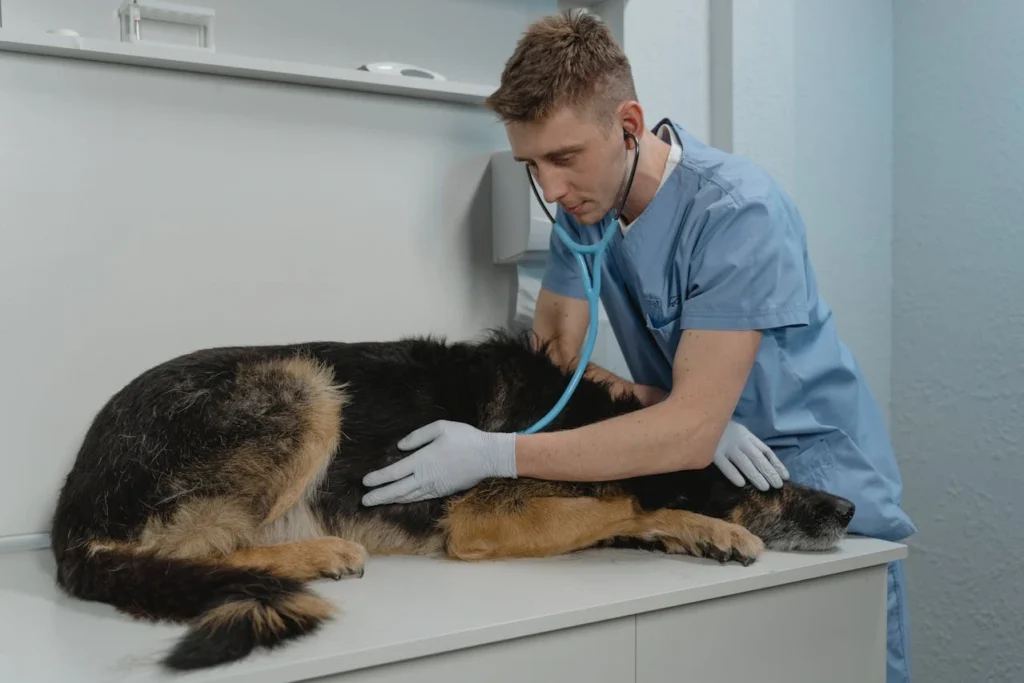Dog Vomiting Blood: Causes, Symptoms, and What to Do Next
The presence of blood in your dog’s vomited material signifies a serious medical condition. This is called hematemesis. Hematemesis signifies injuries or stomach problems or poisoning which results in vomiting blood. You need to act fast.
The following guide provides information about the potential causes of blood vomit in dogs. The instructions provide both observation methods for identifying symptoms and necessary actions to take. The correct decision between emergency help and self-care requires immediate understanding. The proper veterinary treatment becomes possible when you react promptly after your dog vomits blood.
Table of Contents
Understanding Dog Vomiting Blood (Hematemesis)
The medical term for blood in dog vomitus is called canine hematemesis. When blood appears in their vomit it signals stomach or upper digestive tract bleeding. The proper understanding of blood vomiting types depends on recognizing their various forms while evaluating their urgency.
What Exactly Is Hematemesis in Dogs?
Blood in your dog’s vomited material indicates stomach or upper gastrointestinal bleeding referred to as hematemesis. Blood from the vomiting process differs from blood present in the mouth or throat. Your dog needs immediate veterinary attention because this condition requires professional diagnosis about the root cause.
Differentiating Between Fresh and Digested Blood
- Fresh blood: Looks bright red and is mixed with vomit. It means recent bleeding, usually from the stomach or esophagus.
- Digested blood: Looks dark, like coffee grounds. It means older blood, possibly from the lower stomach or intestines.
How Serious Is Blood in Dog Vomit?
Any dog blood in vomit needs attention. How serious it is depends on how often, how much, and other symptoms. If there’s sudden heavy bleeding or weakness, get help right away. Even mild cases should not be ignored and need a vet’s check.
Common Causes of Dog Vomiting Blood
Understanding why dogs vomit blood is key. It can happen from simple things or serious health problems. Here are the main reasons why your dog might throw up blood:
- Gastrointestinal Ulcers: Sores in the stomach or intestines bleed when irritated. This can be from medication, stress, or a bad diet. The blood might look red or dark like coffee grounds.
- Gastritis: Eating spoiled food or toxins can cause inflammation. This leads to vomiting with blood streaks. Dogs that like to scavenge are more likely to get it.
- Toxins or Foreign Objects: Eating chemicals, sharp objects, or bones can hurt the digestive tract. This can cause blood in the vomit.
- Parasites: Worms like hookworms or stomach parasites can damage tissues. This causes bleeding. Puppies and dogs that go outside a lot are at higher risk.
- Infections: Bacterial (like Helicobacter) or viral infections can inflame the stomach lining. This leads to bloody vomit.
- Clotting Disorders: Conditions like von Willebrand’s disease make it hard for blood to clot. This can cause internal bleeding that shows up in vomit.
- Tumors: Growths in the stomach or esophagus may bleed when irritated. Older dogs are more likely to get them.
- Post-Surgery Complications: Recent surgeries near the digestive tract can cause internal bleeding. This happens if there are healing issues.
Some breeds, like German Shepherds, are more prone to gastritis. Small breeds might swallow things they shouldn’t. If your dog keeps vomiting blood, see a vet right away. They can find out why and help your dog feel better.
Recognizing Symptoms That Accompany Bloody Vomit
When your dog shows signs of bloody vomit in dogs, it’s key to notice other symptoms. This helps figure out how urgent it is. Spotting these early can make a big difference in treatment.
Primary Symptoms to Watch For
- Frequent vomiting with visible blood or coffee-ground-like material.
- Dog throwing up and pooping blood—black, tarry stools or red blood in feces.
- Loss of appetite, excessive drooling, or gagging before vomiting.
Secondary Signs of Distress
- Lethargy or rapid breathing indicating internal distress.
- Dry mouth, sunken eyes, or slow skin tenting (dehydration signs).
- Yellow or pale gums, fever, or abnormal abdominal swelling.
Behavior Changes in Dogs
Look out for sudden changes like:
- Refusal to move or adopt a “praying position” (front low, rear high).
- Whining when touched or avoiding normal activities.
- Excessive thirst or refusal to drink water.
Keep a record of all symptoms and when they happen. Tell your vet right away. Quick action can help your dog get better.
When to Consider It an Emergency
Knowing when to seek help for dog vomiting blood can save your pet’s life. Use these guidelines to determine urgency and act promptly.
Red Flags That Require Immediate Veterinary Attention
These situations demand emergency vet for dog vomiting blood care within hours:
- Large volumes of bright red blood (fresh blood)
- Multiple vomiting episodes in 24 hours
- Blood in both vomit and stool
- Dog coughing blood alongside vomiting
- Signs of shock: pale gums, rapid breathing, weakness
- Suspected poisoning or swallowing toxic substances
- Visible abdominal pain or rigid posture
Non-Emergency Situations That Still Need Care
Less urgent but still concerning signs require vet care within 24–48 hours. These include:
- Small streaks of blood mixed with food
- A single episode followed by normal behavior
- Mild vomiting with occasional blood and normal appetite
- Suspected mild dietary indiscretion (e.g., eating grass)
Always call your vet first. Describe symptoms clearly and follow their advice. Prepare your dog’s medical history and recent diet details before arrival.
Diagnostic Process: What Your Veterinarian Will Do

When your dog throws up blood, your vet will act fast. They will use a detailed plan to find the cause. This helps them give the right treatment. Here’s what happens:
- Physical exam: Your vet will check your dog’s vital signs. They will also feel the belly for pain or swelling. And they’ll look at the gums for signs of anemia or dehydration.
- Blood tests: A complete blood count (CBC) checks for infections or anemia. Chemistry panels look at the liver, kidneys, and electrolytes. Clotting tests check for bleeding disorders that could cause dog throwing up blood.
- Imaging studies: X-rays find foreign objects or blockages. Ultrasounds show detailed organ images. Endoscopy lets them see the stomach or upper GI tract for ulcers or tumors.
- Fecal exams: These tests look for parasites, blood cells, or infections that might cause bloody vomit.
- Specialized tests: Biopsies or lab cultures might be needed if the first results are unclear.
Tests are chosen based on symptoms and how urgent they are. Simple cases might get answers quickly, but complex ones could take longer. Remember, each step is important to find out why your dog is throwing up blood. Your vet will guide you to help your pet get better.
Treatment Options for Dog Vomiting Blood
When your dog needs treatment for dog vomiting blood, the vet will decide the best way. The first step is to make your pet stable. Then, they will manage symptoms and fix the problem. Here are the main steps to help your dog get better.
Medical Interventions
Many times, the vet will give medicines to stop vomiting and heal the stomach. They might give:
- Fluid therapy via IV to fight dehydration
- Anti-nausea drugs like maropitant
- Acid reducers such as omeprazole
- Antibiotics for bacterial infections
Surgical Treatments When Necessary
If there’s a tumor, blockage, or severe ulcer, surgery is needed. They might do:
- Removing foreign objects that block the intestines
- Fixing ulcers or removing tumors
- Stitching holes in the stomach or intestines
How long it takes to recover depends on the surgery. But, most pets get better with the right care after surgery.
Home Care During Recovery
You play a big part in helping your dog recover. Here’s what to do:
- Feed a simple diet like boiled chicken and rice for 2-3 days
- Give medicines exactly as told
- Don’t let them exercise too much
- Watch their stool color and how often they vomit every day
“Keeping a regular feeding and medicine schedule is crucial for recovery,” says vet advice.
Going to the vet regularly is important. It makes sure your dog is getting better as planned. Always talk to your vet before changing anything.
Preventing Future Episodes of Bloody Vomit
Keeping your dog’s canine digestive health in check is crucial. It helps prevent dog vomiting blood prevention. Start by making small changes in your dog’s daily life and your home.
Dietary Considerations
Choose high-quality dog food made for sensitive stomachs. Don’t change your dog’s diet suddenly. Instead, do it slowly over 7–10 days.
Don’t give your dog table scraps or foods like chocolate or grapes. If your dog has food allergies, try hypoallergenic foods. But talk to your vet before adding probiotics to their diet.
Environmental Safety Measures
- Secure trash cans and compost bins to prevent scavenging.
- Store chemicals, medications, and toxic plants (e.g., sago palm, lilies) out of reach.
- Inspect yards for sharp objects or poisonous plants like ivy or azaleas.
- Use pet-safe pest control and avoid ingestion of foreign items like toys or sticks.
Regular Health Monitoring
Keep an eye on your dog’s eating, vomiting, and stool habits. Make sure to take them to the vet every year. Follow the vet’s advice on parasite prevention.
Watch for signs like tiredness or less interest in food. Keep a symptom journal to share with your vet.
Conclusion: Supporting Your Dog Through Digestive Health Issues
If your dog vomits blood, act fast and keep up the care. Start by focusing on dog digestive health. Look for early signs and get help from a vet. This way, your dog gets the right treatment and care.
Watching your dog closely is key. Look for changes in how they act, eat, or feel. This helps catch problems early.
Keep your dog healthy with a good diet and a safe place to live. Regular vet visits are also important. Many health issues can be fixed if caught early.
Remember, your dog’s health is in your hands. If you see blood in their vomit, call the vet right away. This is very important.
Preventive care is crucial for your dog’s long-term health. Learn about dog digestive health and follow your vet’s advice. With careful watching and expert help, you can keep your dog happy and healthy.
FAQ
What causes a dog to vomit blood?
Dogs can vomit blood for many reasons. This includes stomach ulcers, gastritis, and eating things they shouldn’t. It can also be due to blood clotting problems or serious issues like tumors or infections.
When should I take my dog to the emergency vet for vomiting blood?
Take your dog to the emergency vet if they vomit a lot of fresh blood. Also, if they vomit blood often, show signs of shock, or have blood in their stool. Quick action is key for serious cases.
What does it mean if a dog vomits blood that looks like coffee grounds?
If your dog’s vomit looks like coffee grounds, it means the blood has digested. This usually comes from the upper stomach. It’s a serious sign that needs vet attention.
Are there specific breeds more likely to vomit blood?
Any dog can vomit blood, but some breeds might be more at risk. This is because of their genetic predispositions to stomach problems or blood disorders. Always talk to your vet about your dog’s breed.
How is blood in dog vomit diagnosed?
Diagnosing blood in vomit involves a few steps. First, a vet will do a physical check-up. Then, they might do blood tests, X-rays, or ultrasounds. Sometimes, they use endoscopy to find the source of bleeding.
What treatment options are available for a dog vomiting blood?
Treatment depends on why your dog is vomiting blood. It might include fluids, medicines to stop nausea, or antibiotics. In some cases, surgery is needed. Always follow your vet’s advice for your dog.
How can I prevent my dog from vomiting blood in the future?
To prevent your dog from vomiting blood, keep harmful chemicals away. Feed them a balanced diet and avoid foods that might upset their stomach. Regular vet visits are also important. Watch your dog closely for any health changes.
Should I be worried if my dog is also pooping blood along with vomiting blood?
Yes, if your dog is vomiting and pooping blood, it’s a serious sign. This could mean a severe health issue. You need to see a vet right away.
Can a dog cough and vomit blood at the same time?
Yes, dogs can cough up blood and vomit blood at the same time. This is a sign of serious health problems. You should get your dog to the vet quickly.
Is it common for dogs to vomit blood?
While dogs can vomit blood, it’s a serious symptom. Many causes are treatable. So, it’s important to get your dog to the vet fast.



